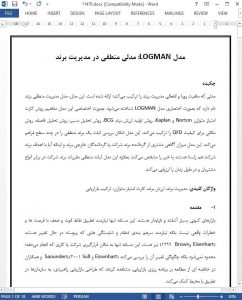Abstract
Proposes a model that combines the proactive and reactive nature of brand management. It is called the logical brand management model, abbreviated to the LOGMAN model. More specifically it combines insights from: Kaplan and Norton's balanced scorecard method; BCG's brand value creation method; the path analysis method; the gap analysis method; and the house of quality (QFD) method. It allows one to perform a logical brand consistency audit at several levels. It evaluates whether customer perceptions of the company's brand drivers and the external brand drivers are in line with the company's brand objectives. Furthermore, it analyzes the logical consistency of the company's brand policy across multiple customer segments and over time.
Introduction
Today’s markets are very turbulent and unstable. This not only asks for “matching” strengths/weaknesses with the actual opportunities/threats, but also for “patching” (continuously changing portfolios and competencies) (see Eisenhardt and Brown, 1999). It is not only about where a company should be or what it should be, but also about how it should proceed (Eisenhardt and Sull, 2001). In their epilogue (summary) of a special issue on exploring marketing planning, Saunders et al. (1996) observe that strategic marketing planning should help organizations to cope better with the environment.
Challenge for future research
It is quite obvious that a similar exercise in integrating different methods cannot only be applied at the brand management level, but also at the strategic (corporate) marketing management level. For instance, the analysis of competencies, organizational structure and performance analysis, which often form part of the internal analysis of a strategic marketing plan, are related to the learning and growth perspective in the balanced scorecard. The external analysis of the strategic marketing plan can be related to the customer and external process perspective. The tactical part of a strategic marketing plan (marketing mix actions) can be related to the internal process perspective. The overall strategy and the evaluation of a strategic marketing plan are related to measures used at the four perspective levels.











